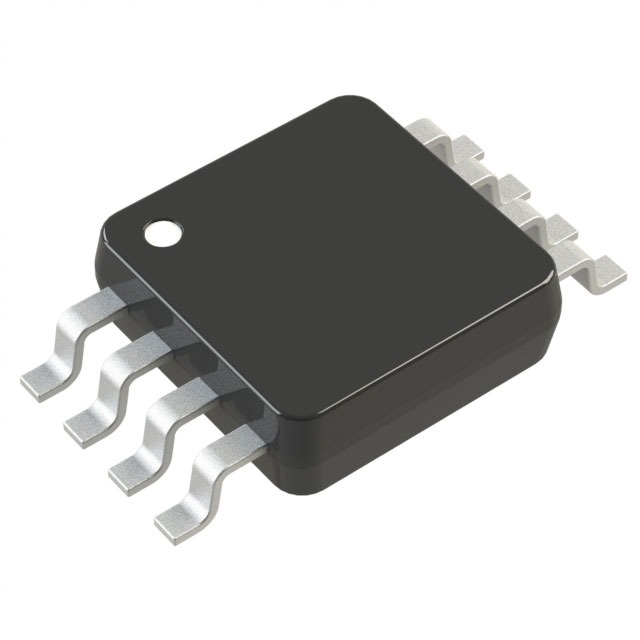Voir les spécifications pour les détails du produit.

AD7303BRMZ-REEL
Product Overview
Category
AD7303BRMZ-REEL belongs to the category of digital-to-analog converters (DACs).
Use
This product is used to convert digital signals into analog signals, allowing for precise control and manipulation of analog systems.
Characteristics
- High resolution: The AD7303BRMZ-REEL offers a resolution of 12 bits, ensuring accurate conversion of digital data.
- Low power consumption: This DAC operates at low power levels, making it suitable for battery-powered devices.
- Small package size: The AD7303BRMZ-REEL comes in a miniature package, enabling its use in space-constrained applications.
- Wide operating voltage range: It can operate within a wide voltage range, providing flexibility in various system designs.
Package and Quantity
The AD7303BRMZ-REEL is available in a small outline integrated circuit (SOIC) package. It is typically sold in reels containing a specific quantity, usually around 250 units per reel.
Specifications
- Resolution: 12 bits
- Operating Voltage Range: 2.7V to 5.5V
- Output Voltage Range: 0V to Vref
- Conversion Rate: Up to 100 kSPS (thousand samples per second)
- Interface: Serial, SPI-compatible
Pin Configuration
The AD7303BRMZ-REEL has a total of 8 pins, which are assigned specific functions as follows:
- VDD: Power supply voltage input
- DIN: Serial data input
- SCLK: Serial clock input
- CS: Chip select input
- VOUT: Analog output voltage
- AGND: Analog ground
- DGND: Digital ground
- VREF: Reference voltage input
Functional Features
- High accuracy: The AD7303BRMZ-REEL provides precise analog output, ensuring minimal errors in the conversion process.
- Fast conversion rate: With a maximum conversion rate of 100 kSPS, this DAC can quickly respond to changes in the digital input signal.
- Low glitch energy: The AD7303BRMZ-REEL minimizes glitches during transitions, resulting in smooth and stable analog output.
Advantages and Disadvantages
Advantages
- High resolution allows for fine-grained control of analog systems.
- Low power consumption makes it suitable for portable and battery-powered devices.
- Small package size enables use in space-constrained applications.
- Wide operating voltage range provides flexibility in system design.
Disadvantages
- Limited output voltage range may not be suitable for applications requiring higher voltage levels.
- Serial interface limits the speed of data transfer compared to parallel interfaces.
Working Principles
The AD7303BRMZ-REEL operates by converting digital input signals into corresponding analog voltages. It utilizes an internal digital-to-analog conversion technique that accurately translates the binary data into analog form. The converted analog voltage is then available at the VOUT pin for further processing or direct use in analog systems.
Detailed Application Field Plans
The AD7303BRMZ-REEL finds applications in various fields, including but not limited to: - Industrial automation: Control of analog actuators and sensors. - Audio equipment: Precise volume control and audio signal processing. - Instrumentation: Calibration and measurement systems. - Communication systems: Analog signal modulation and demodulation. - Automotive electronics: Control of analog subsystems in vehicles.
Alternative Models
For those seeking alternative options, the following models are worth considering: - AD7304BRMZ-REEL: Similar to AD7303BRMZ-REEL but with 4 channels instead of 1. - AD5310BRMZ: 10-bit DAC with similar characteristics and package size. - AD5662BRMZ-1: 16-bit DAC offering higher resolution.
These alternative models provide different resolutions, channel counts, or additional features to suit specific application requirements.
In conclusion, the AD7303BRMZ-REEL is a high-resolution digital-to-analog converter that offers precise control over analog systems. Its small package size, low power consumption, and wide operating voltage range make it suitable for various applications. However, its limited output voltage range and serial interface may pose limitations in certain scenarios. Nonetheless, this DAC provides an efficient solution for converting digital signals into accurate analog voltages.
Énumérez 10 questions et réponses courantes liées à l'application de AD7303BRMZ-REEL dans les solutions techniques
Sure! Here are 10 common questions and answers related to the application of AD7303BRMZ-REEL in technical solutions:
Q: What is the AD7303BRMZ-REEL? A: The AD7303BRMZ-REEL is a digital-to-analog converter (DAC) IC manufactured by Analog Devices.
Q: What is the resolution of the AD7303BRMZ-REEL? A: The AD7303BRMZ-REEL has a resolution of 8 bits, meaning it can convert digital input into analog output with 256 possible levels.
Q: What is the supply voltage range for the AD7303BRMZ-REEL? A: The AD7303BRMZ-REEL operates with a supply voltage range of 2.7V to 5.5V.
Q: What is the typical power consumption of the AD7303BRMZ-REEL? A: The AD7303BRMZ-REEL has a typical power consumption of 0.6mW at a 3V supply voltage.
Q: What is the interface used to communicate with the AD7303BRMZ-REEL? A: The AD7303BRMZ-REEL uses a serial interface called SPI (Serial Peripheral Interface) for communication.
Q: Can the AD7303BRMZ-REEL be used in both single-ended and differential output configurations? A: Yes, the AD7303BRMZ-REEL can be configured for both single-ended and differential output modes.
Q: What is the settling time of the AD7303BRMZ-REEL? A: The settling time of the AD7303BRMZ-REEL is typically 4μs, which refers to the time it takes for the output voltage to stabilize after a change in the digital input.
Q: Can the AD7303BRMZ-REEL operate in a temperature range outside of the industrial range? A: No, the AD7303BRMZ-REEL is designed to operate within the industrial temperature range of -40°C to +85°C.
Q: Does the AD7303BRMZ-REEL have any built-in reference voltage source? A: No, the AD7303BRMZ-REEL requires an external reference voltage source for accurate conversion.
Q: What are some typical applications of the AD7303BRMZ-REEL? A: The AD7303BRMZ-REEL is commonly used in applications such as industrial automation, instrumentation, data acquisition systems, and control systems where precise analog outputs are required.
Please note that these answers are general and may vary depending on specific requirements and use cases.

